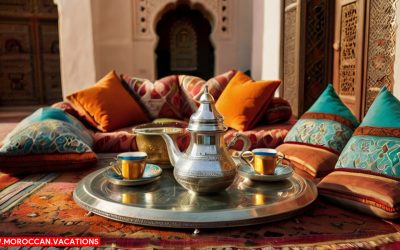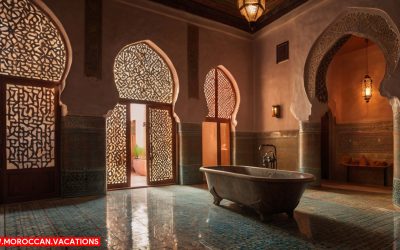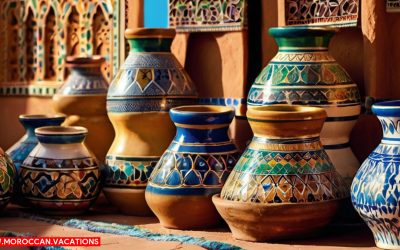History of Henna in Morocco
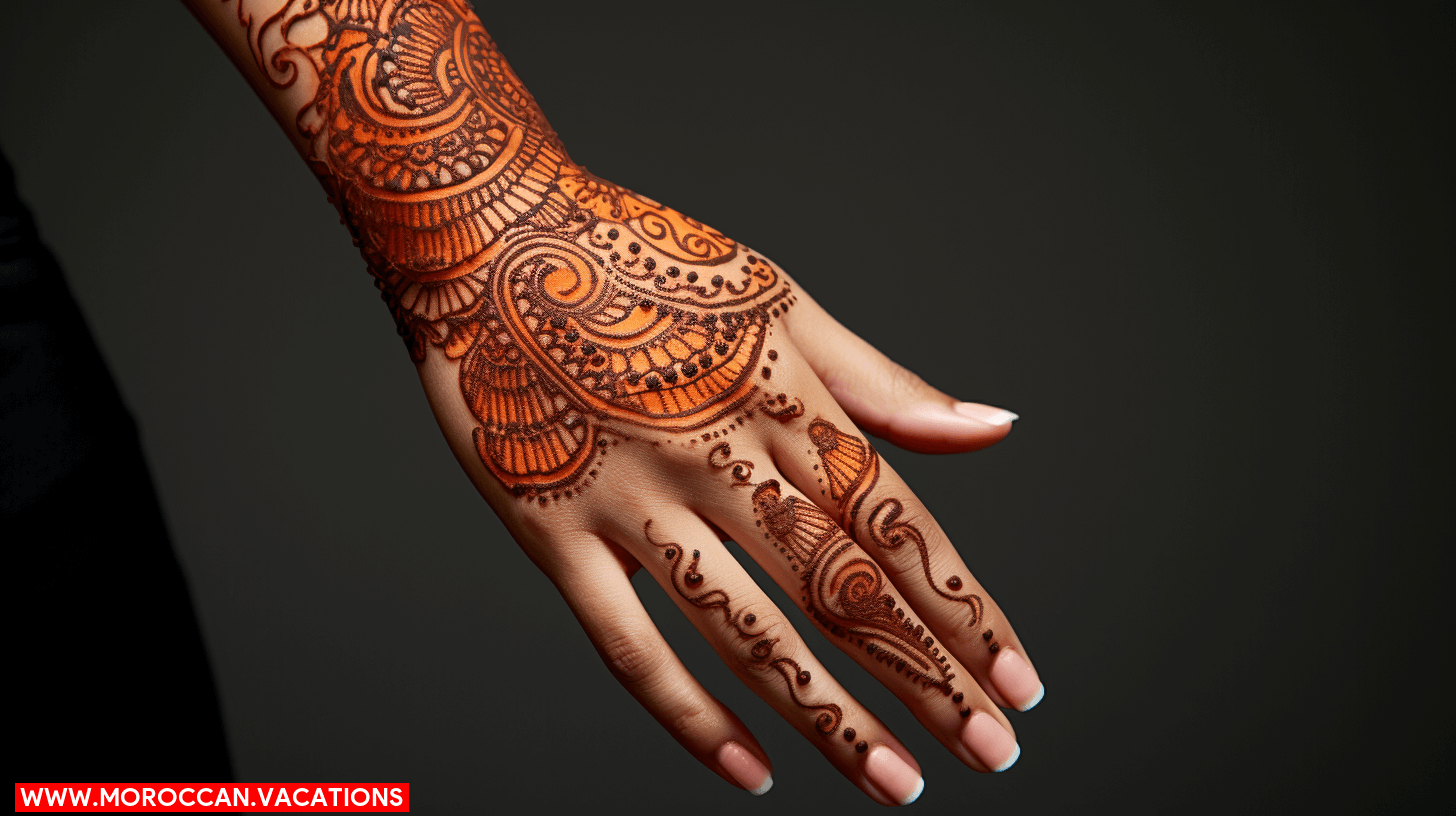

You’ve seen henna, an integral part of Moroccan beauty. But have you ever explored its deeper significance? It’s more than just body art; it’s a vibrant tapestry of culture, tradition, and symbolism. As you delve into its rich history, uncover the mystic symbolism in its designs, and witness its role in Moroccan femininity and weddings, you’ll understand why it’s cherished. Come on, let’s unravel this fascinating narrative of henna beyond beauty.
Let’s dive into the rich history of henna in Morocco, a tradition that’s been deeply ingrained in the country’s culture for centuries. Henna agriculture has been a vital part of Moroccan economy and lifestyle, with many families dedicating their lives to growing, harvesting, and distributing this precious material.
The production of henna is labor-intensive, yet the process reflects the Moroccan spirit of freedom. You see, every aspect, from seed planting to grinding leaves into powder, involves a deep connection to the land and an enduring sense of independence. It’s a symbol of the Moroccan spirit, a testament to the hard work and resilience of the people.
Now, let’s talk about henna tattoos. These intricate designs are more than just decorative. They’re a form of self-expression, a celebration of life’s milestones. The application of henna tattoos, called Naqsh, is an art form in itself. Each motif tells a story, symbolizing protection, prosperity, or love. These tattoos are a manifestation of the individual’s freedom to express their personal journey and their connection to Moroccan heritage.
Cultural Significance of Henna
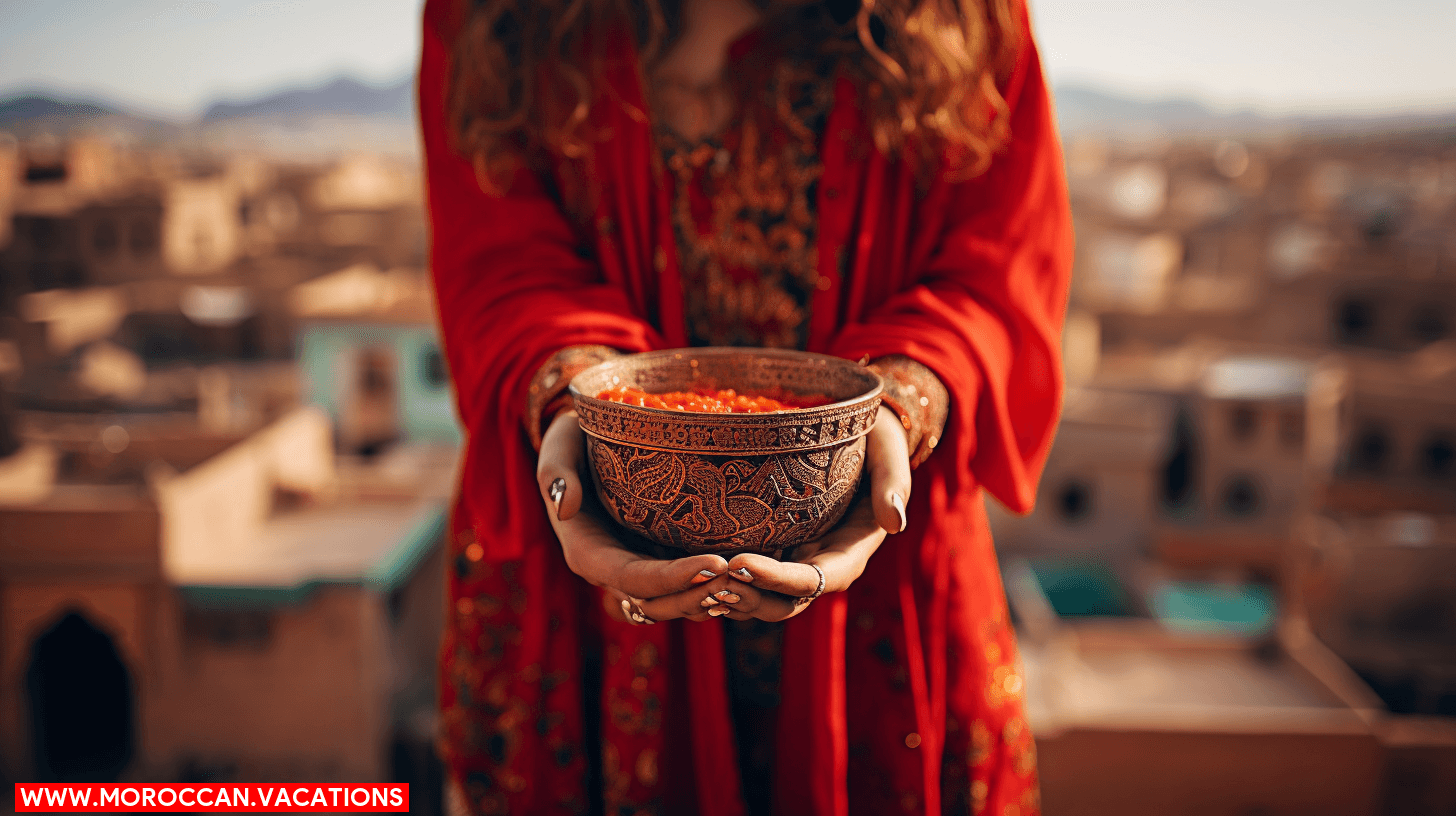

Delving into the cultural significance of henna, you’ll discover that it’s more than a mere aesthetic adornment in Moroccan society. Henna tattoos, intricately drawn on hands and feet, are not just about beautifying oneself, they’re a form of self-expression and cultural identity.
- Symbolism: Henna designs are often imbued with cultural symbols. For instance, flowers may signify joy and happiness, while birds can represent freedom and independence. These aren’t just drawings, they’re an expression of one’s inner world.
- Rites of Passage: Henna preparation and application are an integral part of Moroccan rituals, especially during weddings. The bride’s hands and feet are adorned with henna, signifying her transition into marriage.
- Protection: Henna tattoos are believed to ward off evil and bring good luck. It’s a spiritual shield, offering protection in a world full of uncertainties.
- Community Bonding: The act of applying henna is communal. It’s about women coming together, sharing stories, and strengthening bonds. It’s a practice that fosters unity and sisterhood.
Henna in Moroccan Weddings
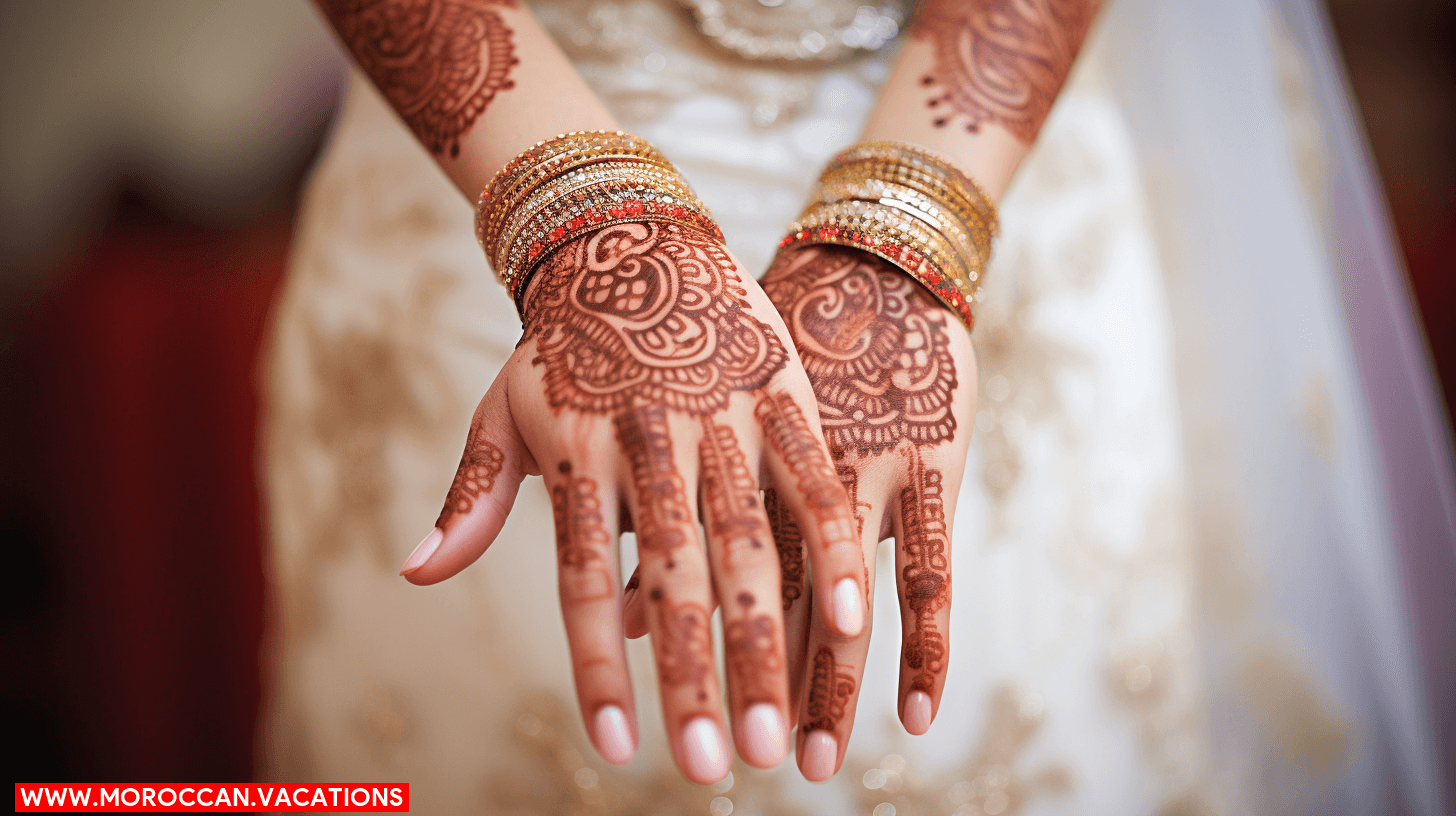

Though you may be familiar with the aesthetic appeal of henna, it’s during Moroccan weddings that you’ll truly see its deep cultural significance come to life. Traditionally, Bridal Henna Rituals are a vital part of the marriage ceremony, symbolizing joy, beauty, and spiritual awakening.
Henna Preparation Techniques, long-held and passed down through generations, reflect a cultural devotion to detail and precision. The henna paste, crafted from crushed henna leaves and essential oils, must be mixed just so, achieving a perfect consistency that will impart deep, long-lasting color.
The application process is a momentous event, usually conducted by a skilled henna artist who adorns the bride’s hands and feet with intricate designs. Each symbol, each line, carries a specific meaning, from protection against the evil eye to blessings for fertility and prosperity. The bride’s henna-stained skin is not merely a beautification process, but a canvas depicting the hopes and dreams of her new journey.
The henna ritual is a potent symbol of freedom. It’s the bride’s personal moment to embrace her cultural roots while stepping into a new phase of life. In essence, the henna’s transient beauty echoes the transformative nature of marriage itself, blending tradition with the personal evolution that love and commitment bring.
Symbolism in Henna Designs
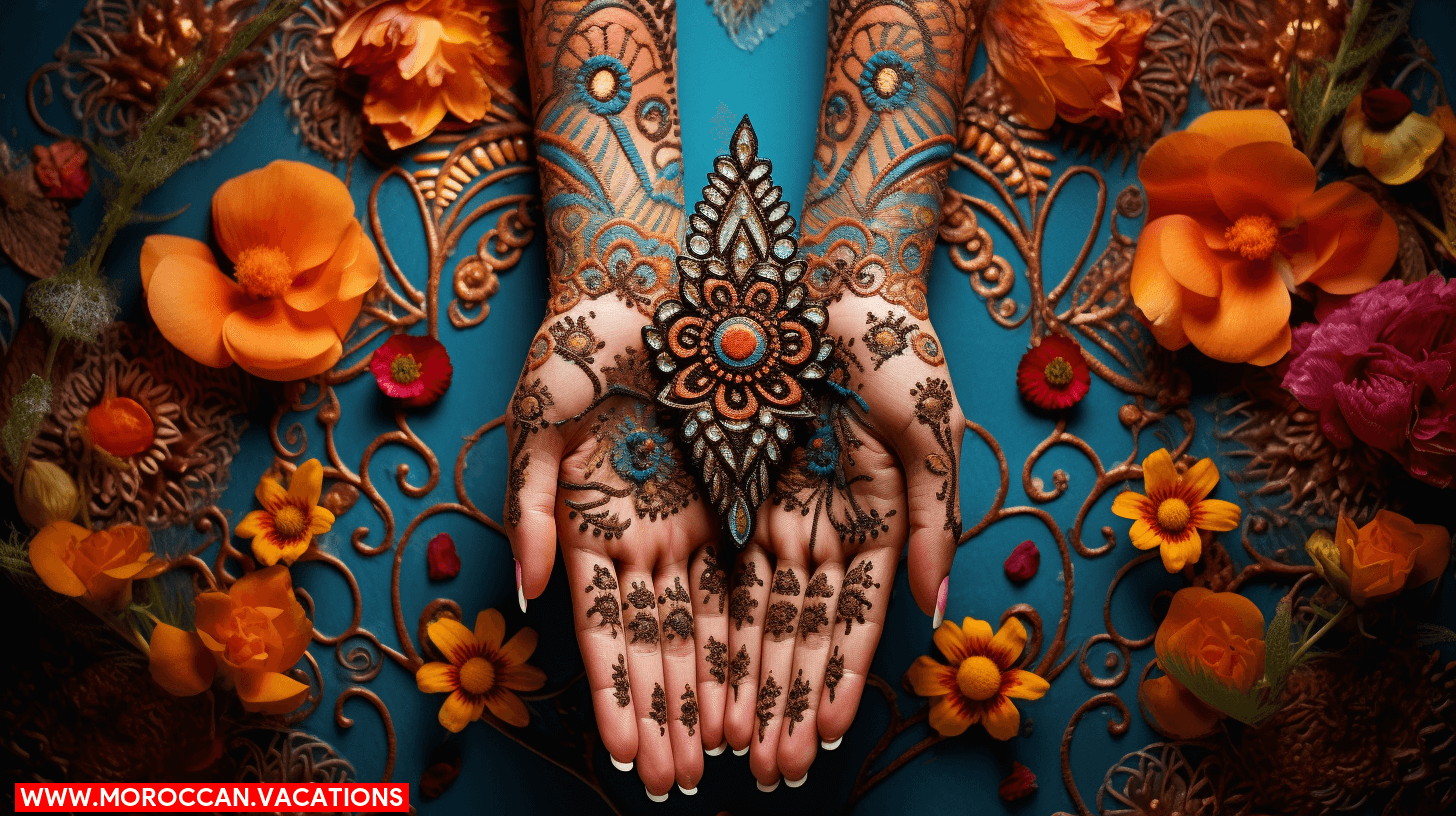

Often, you’ll find that every swirl and dot in a henna design isn’t just for show, they’re steeped in centuries-old symbolism and cultural significance.
- The peacock, a common element, symbolizes beauty and grace. It’s a favorite in henna designs, not just for its visual appeal, but also for its representation of elegance and allure, often used in henna in fashion.
- The lotus flower, with its firm roots in the mud and beautiful bloom above the water, represents resilience and spiritual awakening. It’s an affirmation of one’s ability to rise above challenges.
- In Moroccan designs, the ‘khamsa’ or Hand of Fatima is a powerful symbol of protection and luck. It’s believed to ward off evil and bring blessings.
- The spiral, a symbol of the universe’s infinite nature, represents growth and evolution. It’s a reminder of life’s ongoing journey and the constant change it brings.
These symbols don’t just make a henna design visually stunning, they add a layer of depth that resonates with the wearer’s life journey. Besides the aesthetic appeal, henna’s healing properties are believed to bring emotional well-being, making it a holistic experience that’s more than skin-deep.
Moroccan Henna and Femininity
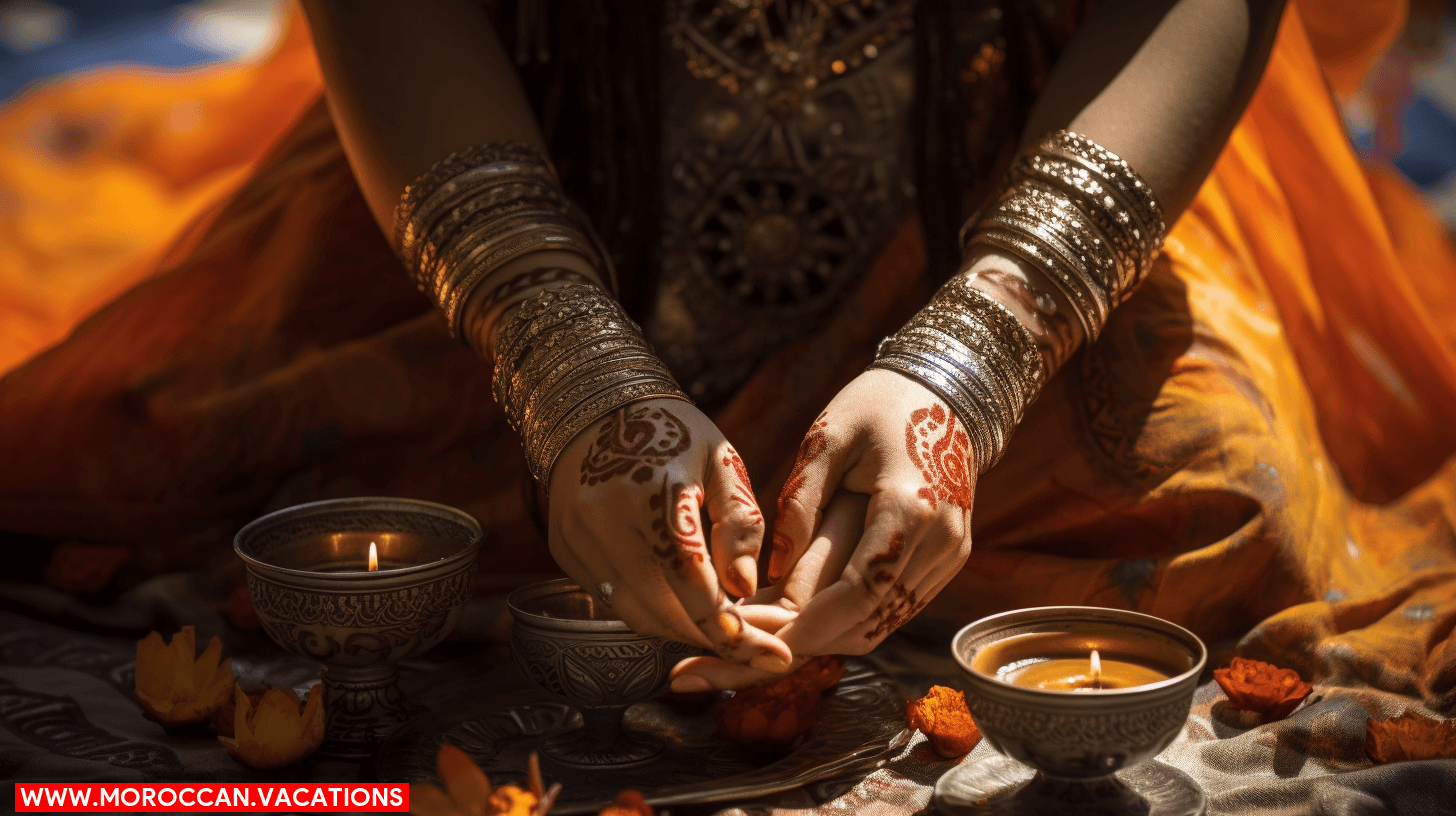

In your exploration of Moroccan henna designs, you’ll notice a distinct emphasis on femininity, carrying forward the cultural significance discussed earlier. The intricate details and patterns aren’t just aesthetic choices; they’re a manifestation of the central role women play in Moroccan society. Henna empowerment isn’t just about the beautiful designs drawn on the skin, it’s a testament to the strength and resilience of Moroccan women.
These designs, applied during women’s rituals such as weddings and childbirth, serve as a visual narrative, embodying a woman’s journey. They symbolize fertility, protection, and luck, but on a deeper level, they also reflect the changing phases of a woman’s life.
The act of applying henna itself is a bonding experience, an intimate ritual among women that fosters a sense of unity. This ceremony isn’t only about adorning oneself, but also a celebration of femininity and empowerment. Each stroke of the henna cone is an affirmation of a woman’s individuality and freedom.
Henna in Birth Celebrations
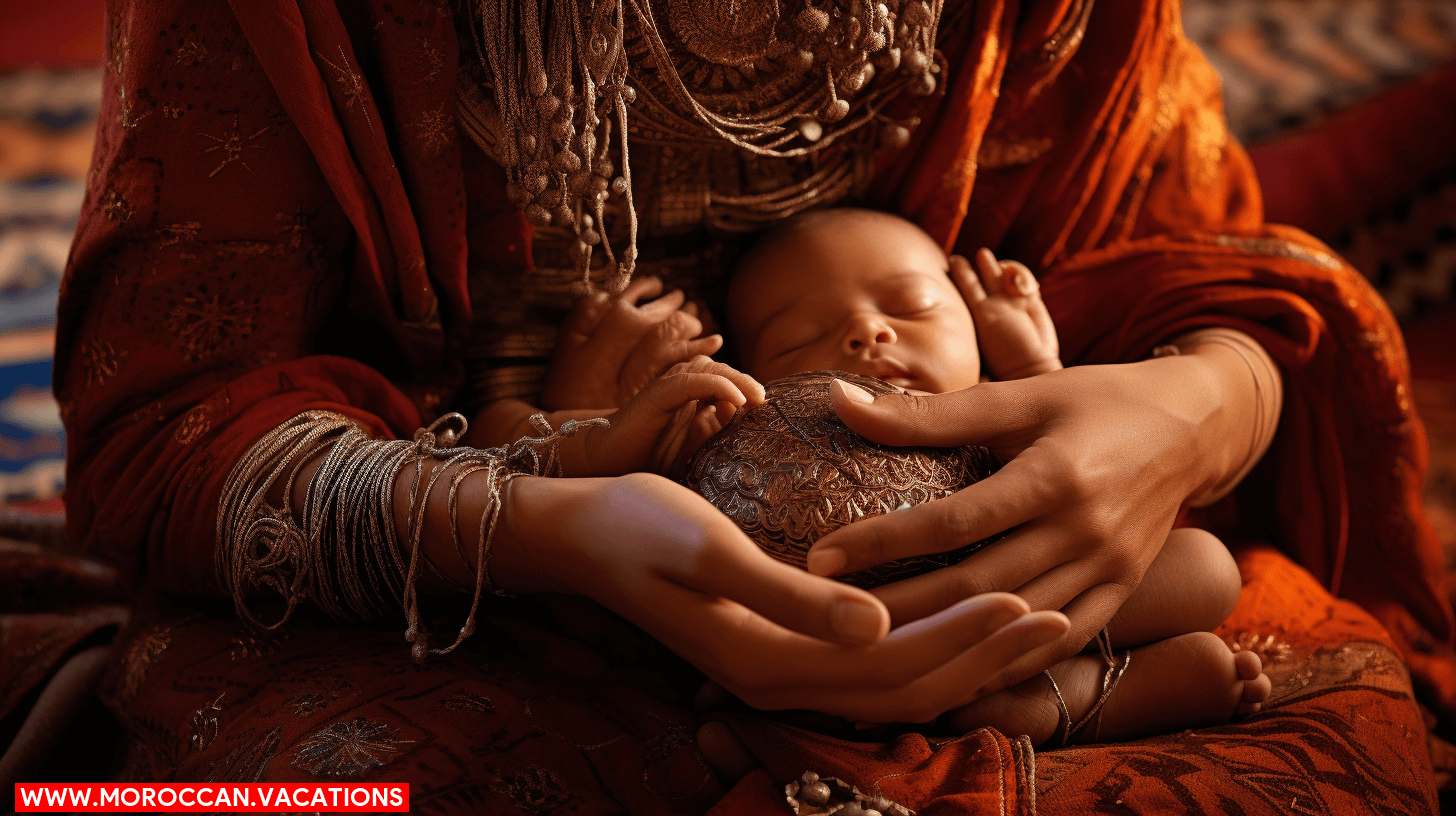

As you delve deeper into the cultural significance of henna, you’ll find that birth celebrations are a particularly powerful testament to its importance in Moroccan society. These ceremonies are transformed into vibrant displays of tradition, symbolism, and cultural identity through the use of henna.
- Henna Healing Properties: You’ll notice that henna is not just a decorative element. It’s believed to possess therapeutic properties that protect the mother and newborn. The henna’s cooling effect is thought to balance the body’s heat, promoting wellness and warding off evil spirits.
- Henna Preparation Techniques: The method of preparing the henna paste is an art in itself. Women gather to grind henna leaves into a fine powder, mix it with water, sugar, and essential oils, then apply the paste using traditional tools.
- Designs and Symbols: Each henna pattern carries a unique meaning. Symbols of fertility, protection, and luck are often featured in these designs.
- Community Bonding: Henna parties foster a sense of community. Women come together to celebrate, support the mother-to-be, share stories, and pass down traditions.
While the aesthetics of henna are indeed captivating, its cultural significance and the freedom it represents in Moroccan society are what truly make it remarkable.
Henna as a Social Practice
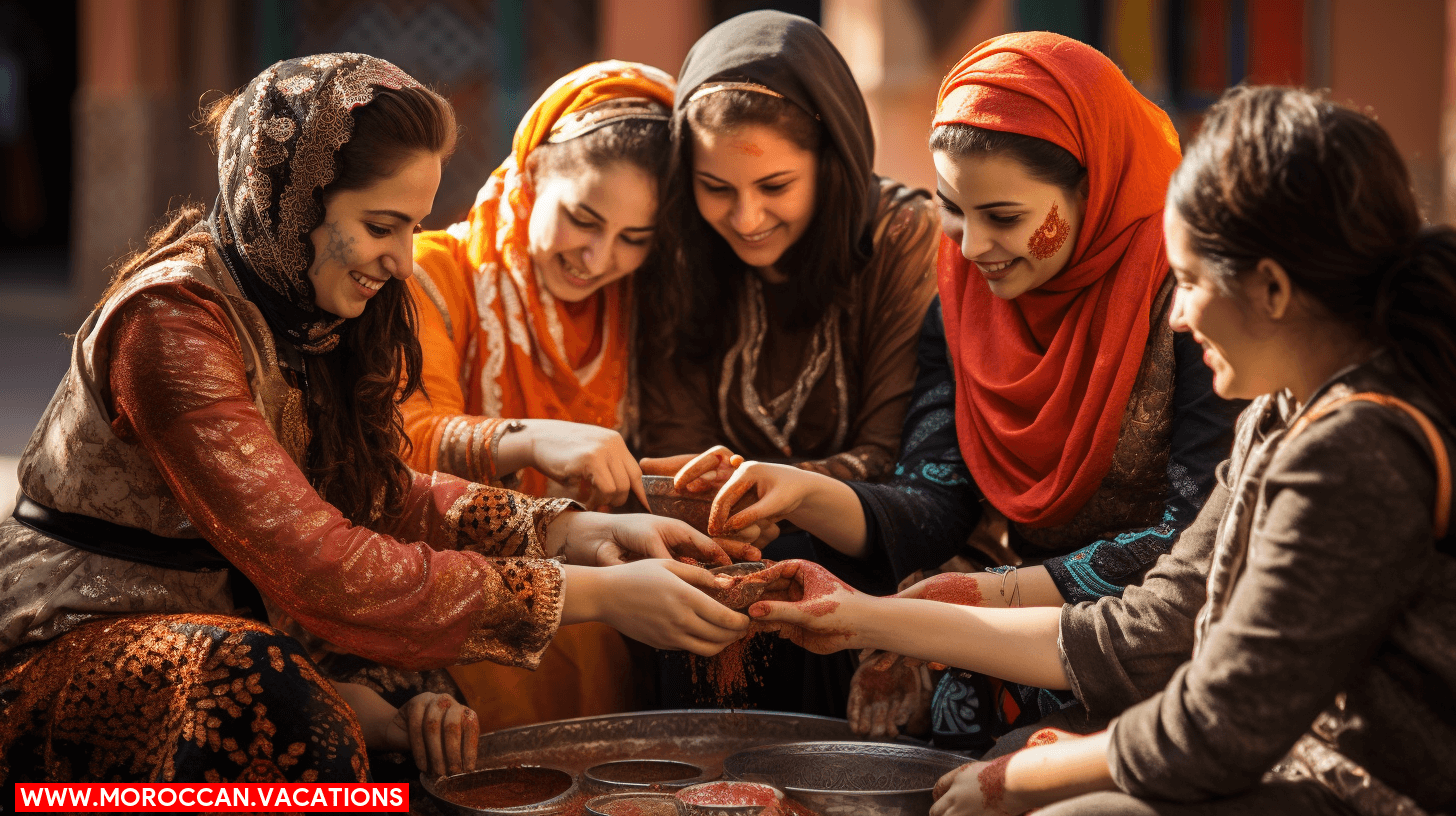

While you’re marveling at the artistic aspect of henna and its role in birth celebrations, you’ll find that it’s also deeply entrenched in Moroccan society as a social practice. Beyond mere decoration, henna preparation and the ceremonies that follow are vital community events, fostering unity and shared experiences.
Henna preparation itself is a communal act, with women gathering to grind the leaves and mix the paste. This process is a time for social interaction, storytelling, and shared wisdom. It’s a moment of communal involvement, a testament to women’s solidarity.
Henna ceremonies, on the other hand, are grand affairs often characterized by music, dance, and feasting. They serve as both public declarations of joy and private moments of connection. Participants in these ceremonies don’t merely observe; they actively engage, applying henna to each other’s skin in intricate designs that carry specific meanings and blessings.
In essence, henna is more than a beauty ritual. It’s a social practice that encourages community participation, symbolizes important life stages, and strengthens bonds among women. So, as you appreciate the mesmerizing designs of henna, remember the significant cultural and social implications embedded in these practices.
Contemporary Uses of Henna


Now, let’s turn your attention to the evolution and contemporary uses of henna, an enduring symbol of cultural expression that’s continually adapting to modern trends. This vibrant medium, once confined to traditional ceremonies, has found a thriving place in the world of global aesthetics, fashion, and body art.
- Henna Tattoos: These temporary tattoos have grown in popularity, especially in the West. The intricate designs often carry a sense of exotic appeal and personal expression without the permanence of a conventional tattoo.
- Henna in Fashion: High-end designers and fashion houses are turning to henna-inspired prints and patterns, infusing their creations with an oriental touch that’s both bold and elegant.
- Beauty Products: Many cosmetic brands now incorporate henna in their products, from hair dyes to nail polishes, capitalizing on its natural, chemical-free properties.
- Artistic Expression: Artists and influencers are using henna as a tool for their creative endeavors, creating intricate murals, paintings, and decor items.
As you can see, henna’s evolution is a testament to cultural exchange and adaptation. Its traditional roots remain, but its branches stretch into new realms, embracing the freedom of modernity while honoring its ancestral heritage.
Spiritual Aspects of Henna
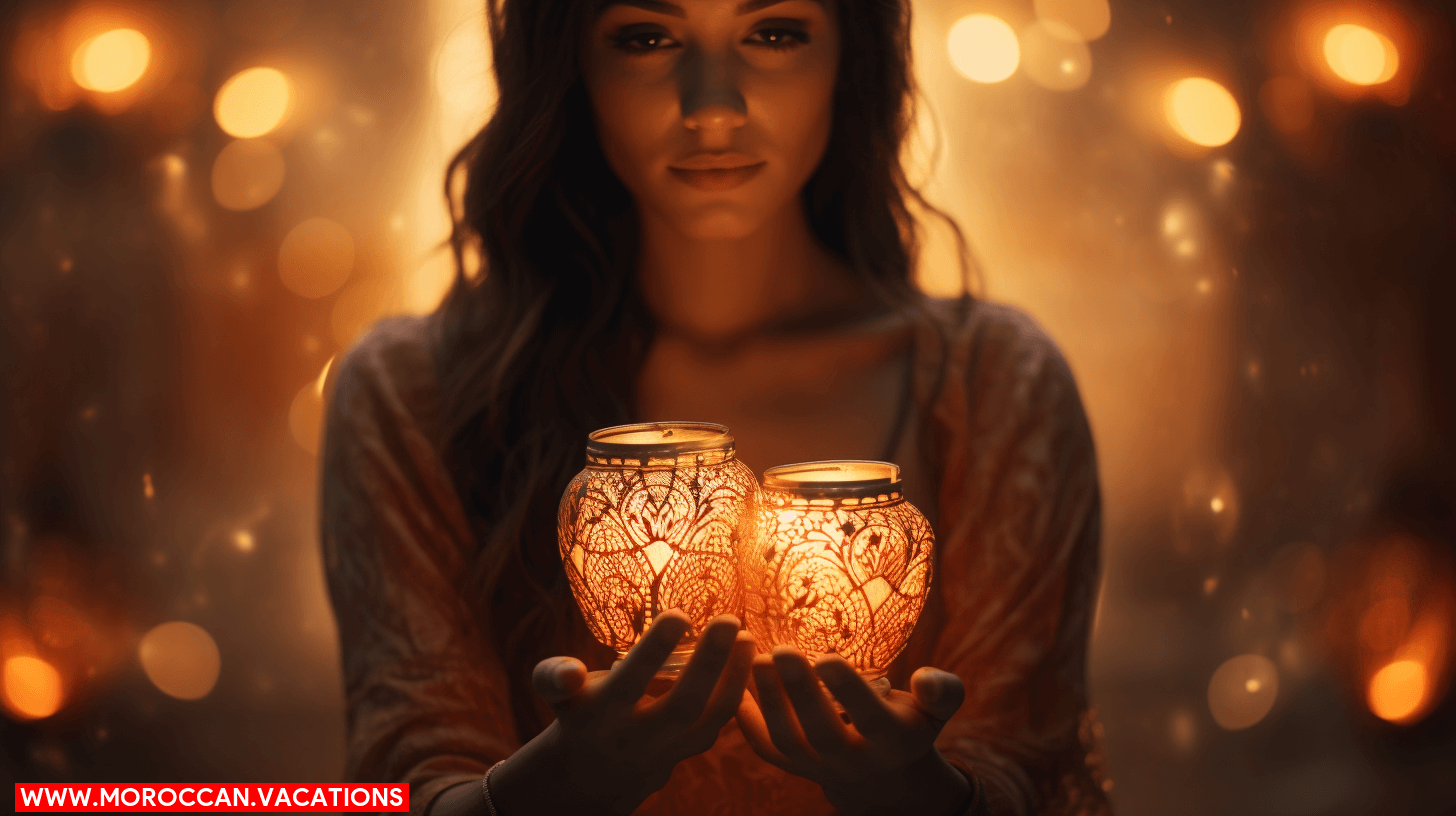

Beyond its modern uses and aesthetic appeal, you’ll find that henna holds a profound spiritual significance in Moroccan culture. This isn’t just about beautifying the body. Henna healing properties are revered, believed to ward off evil and bring good fortune. It’s a spiritual armor, a tangible form of protection and blessing that you can draw onto your skin.
However, there are henna tattoo misconceptions. Many in the West view these intricate designs purely as body art, a temporary alternative to permanent tattoos. They overlook the deep spiritual symbolism embedded in each swirl and dot. In Moroccan culture, each design has a specific meaning, an invocation for health, fertility, or protection.
It’s important to remember that henna isn’t just a fashion statement. It’s a spiritual practice, a prayer made visible, a testament to the Moroccan people’s firm belief in the seen and unseen powers of the universe. It’s a freedom of expression, a manifestation of faith. As you trace the lines of a henna tattoo, know that you’re not just adorning your skin. You’re partaking in a rich, spiritual tradition, a testament to the depth and beauty of Moroccan culture.
Preserving the Art of Henna
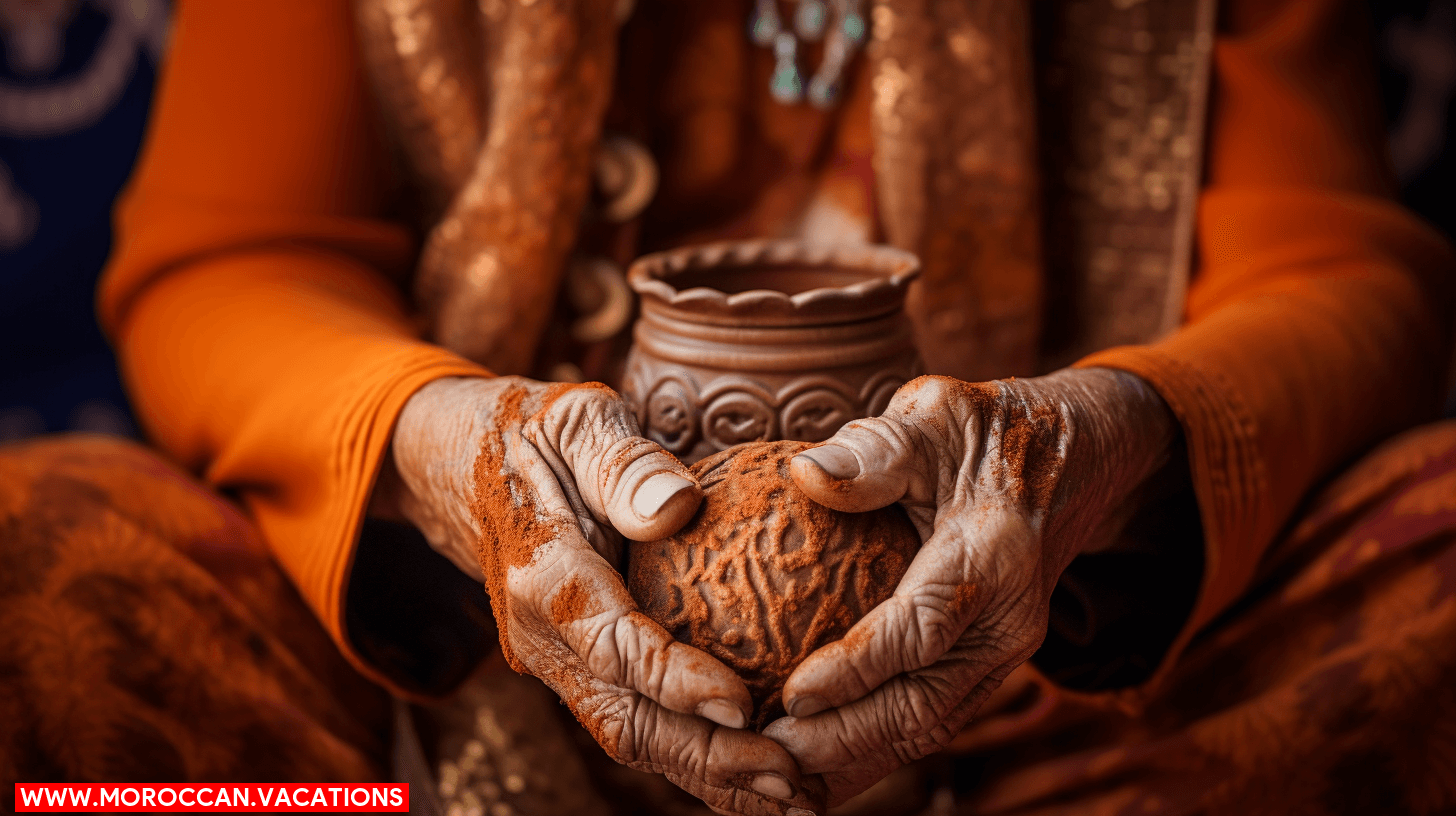

In your journey to understand henna’s cultural significance, you’ll discover that preserving this ancient art form isn’t just about maintaining a millennia-old tradition, it’s also a crucial step in safeguarding the spiritual heritage of Moroccan culture. This preservation, or Henna Conservation, requires a deep understanding of Henna Techniques, a commitment to practice, and a respect for the art’s cultural roots.
Here are four key actions you can take to contribute to this preservation:
- Learn Traditional Techniques: Grasp the complexity of henna designs by learning from seasoned artists. This helps preserve the authentic craft.
- Respect the Cultural Significance: Understand the symbolism behind the intricate patterns. It’s not just art, it’s a rich tapestry of cultural narratives.
- Promote Authentic Henna Art: Encourage the use of traditional henna in today’s fashion world, challenging the dilution of this sacred art.
- Support Henna Artists: By buying directly from traditional henna artists, you’re ensuring their livelihood and the continuation of this art form.
Introducing Ayoub Karbachi, a brilliant wordsmith and curator of the Moroccan Vacations website. Prepare to immerse yourself in mesmerizing narratives and extraordinary moments, as he unveils the allure of Morocco's captivating destinations like never before.
Related Articles
Moroccan Tea Culture: The Art of Mint Tea and Socializing
The Origins of Moroccan Tea Imagine yourself sitting in a bustling Moroccan café, the air thick with the aroma of mint tea. The clinking of glasses and laughter fill the air as people gather to socialize and connect over this cherished beverage. Moroccan Tea Culture:...
Marrakesh's Historical Hammams: Bathhouses With Architectural Grace
Origins of Marrakesh's Hammams Imagine stepping into a world of architectural marvels, where ancient traditions and modern luxury intertwine. Welcome to Marrakesh's historical hammams, where the artistry of the past meets the indulgence of the present. In these...
Cultural Experiences: Local Artisans and Their Crafts in Dades Valley
Dades Valley: A Cultural Overview You're about to embark on a vivid journey, exploring the heart of Dades Valley. Here, 60% of residents are skilled artisans. As you wander, you'll feel the pulse of centuries-old traditions alive in their crafts. You're not just...

